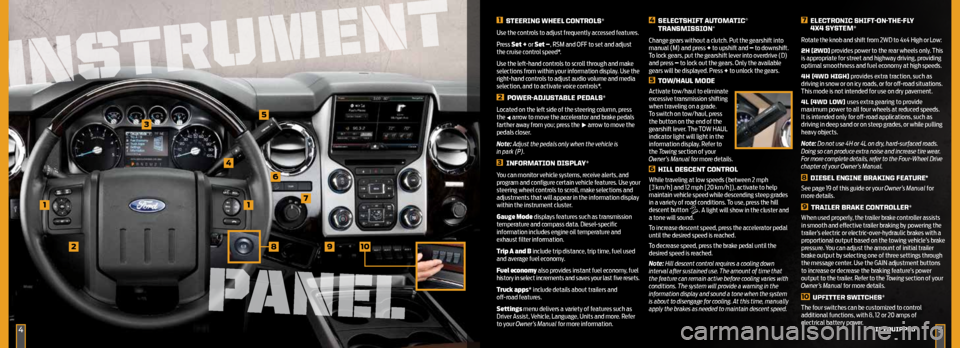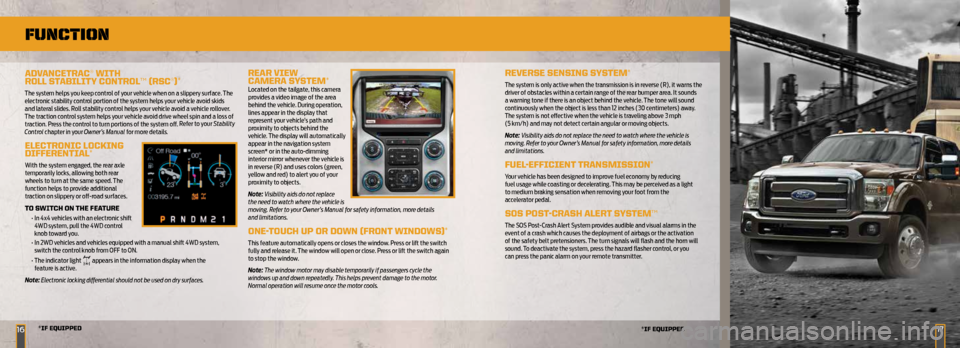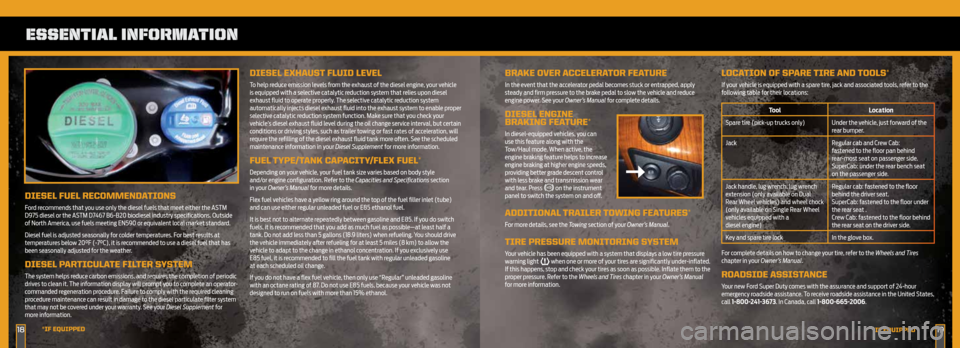warning light FORD SUPER DUTY 2015 3.G Quick Reference Guide
[x] Cancel search | Manufacturer: FORD, Model Year: 2015, Model line: SUPER DUTY, Model: FORD SUPER DUTY 2015 3.GPages: 10, PDF Size: 1.56 MB
Page 3 of 10

1
3
4
2
5
7
6
9
1 STEERING WHEEL CONTROLS*
Use the controls to adjust frequently accessed features.
Press Set + or Set –, RSM and OFF to set and adjust
the cruise control speed* .
Use the left-hand controls to scroll through and make
selections from within your information display. Use the
right-hand controls to adjust audio volume and media
selection, and to activate voice controls* .
2
POWER-ADJUSTABLE PEDALS*
Located on the left side of the steering column, press
the
arrow to move the accelerator and brake pedals
farther away from you; press the arrow to move the
pedals closer.
Note: Adjust the pedals only when the vehicle is
in park (P).
3 INFORMATION DISPLAY*
You can monitor vehicle systems, receive alerts, and
program and configure certain vehicle features. Use your
steering wheel controls to scroll, make selections and
adjustments that will appear in the information display
within the instrument cluster.
Gauge Mode displays features such as transmission
temperature and compass data. Diesel-specific
information includes engine oil temperature and
exhaust filter information.
Trip A and B include trip distance, trip time, fuel used
and average fuel economy.
Fuel economy also provides instant fuel economy, fuel
history in select increments and saves your last five resets.
Truck apps* include details about trailers and
off-road features.
Settings menu delivers a variety of features such as
Driver Assist, Vehicle, Language, Units and more. Refer
to your Owner’s Manual for more information.
4 SELECTSHIFT AUTOMATIC®
TRANSMISSION*
Change gears without a clutch. Put the gearshift into
manual (M) and press + to upshift and – to downshift.
To lock gears, put the gearshift lever into overdrive (D)
and press – to lock out the gears. Only the available
gears will be displayed. Press + to unlock the gears.
5 TOW/HAUL MODE
Activate tow/haul to eliminate
excessive transmission shifting
when traveling on a grade.
To switch on tow/haul, press
the button on the end of the
gearshift lever. The TOW HAUL
indicator light will light in the
information display. Refer to
the Towing section of your
Owner’s Manual for more details.
6 HILL DESCENT CONTROL
While traveling at low speeds (between 2 mph
[3 km/h] and 12 mph [20 km/h]), activate to help
maintain vehicle speed while descending steep grades
in a variety of road conditions. To use, press the hill
descent button
. A light will show in the cluster and
a tone will sound.
To increase descent speed, press the accelerator pedal
until the desired speed is reached.
To decrease speed, press the brake pedal until the
desired speed is reached.
Note: Hill descent control requires a cooling down
interval after sustained use. The amount of time that
the feature can remain active before cooling varies with
conditions. The system will provide a warning in the
information display and sound a tone when the system
is about to disengage for cooling. At this time, manually
apply the brakes as needed to maintain descent speed.
7 ELECTRONIC SHIFT-ON-THE-FLY
4X4 SYSTEM*
Rotate the knob and shift from 2WD to 4x4 High or Low:
2H (2WD) provides power to the rear wheels only. This
is appropriate for street and highway driving, providing
optimal smoothness and fuel economy at high speeds.
4H (4WD HIGH) provides extra traction, such as
driving in snow or on icy roads, or for off-road situations.
This mode is not intended for use on dry pavement.
4L (4WD LOW) uses extra gearing to provide
maximum power to all four wheels at reduced speeds.
It is intended only for off-road applications, such as
driving in deep sand or on steep grades, or while pulling
heavy objects.
Note: Do not use 4H or 4L on dry, hard-surfaced roads.
Doing so can produce extra noise and increase tire wear.
For more complete details, refer to the Four-Wheel Drive
chapter of your Owner’s Manual.
8 DIESEL ENGINE BRAKING FEATURE*
See page 19 of this guide or your Owner’s Manual for
more details.
9
TRAILER BRAKE CONTROLLER*
When used properly, the trailer brake controller assists
in smooth and effective trailer braking by powering the
trailer’s electric or electric-over-hydraulic brakes with a
proportional output based on the towing vehicle’s brake
pressure. You can adjust the amount of initial trailer
brake output by selecting one of three settings through
the message center. Use the GAIN adjustment buttons
to increase or decrease the braking feature’s power
output to the trailer. Refer to the Towing section of your
Owner’s Manual for more details.
10 UPFITTER SWITCHES*
The four switches can be customized to control
additional functions, with 8, 12 or 20 amps of
electrical battery power.
1
10
*IF EQUIPPED45
8
INSTRUMENT
INSTRUMENT
PANEL
Page 9 of 10

*IF EQUIPPED16
ADVANCETRAC® WITH
ROLL STABILITY CONTROL™ (RSC®)*
The system helps you keep control of your vehicle when on a slippery surface. The
electronic stability control portion of the system helps your vehicle avoid skids
and lateral slides. Roll stability control helps your vehicle avoid a vehicle rollover.
The traction control system helps your vehicle avoid drive wheel spin and a loss of
traction. Press the control to turn portions of the system off. Refer to your Stability
Control chapter in your Owner’s Manual for more details.
ELECTRONIC LOCKING
DIFFERENTIAL*
With the system engaged, the rear axle
temporarily locks, allowing both rear
wheels to turn at the same speed. The
function helps to provide additional
traction on slippery or off-road surfaces.
TO SWITCH ON THE FEATURE
• In 4x4 vehicles with an electronic shift
4WD system, pull the 4WD control
knob toward you.
• In 2WD vehicles and vehicles equipped with a manual shift 4WD system,
switch the control knob from OFF to ON.
• The indicator light
appears in the information display when the
feature is active.
Note: Electronic locking differential should not be used on dry surfaces.
REAR VIEW
CAMERA SYSTEM*
Located on the tailgate, this camera
provides a video image of the area
behind the vehicle. During operation,
lines appear in the display that
represent your vehicle’s path and
proximity to objects behind the
vehicle. The display will automatically
appear in the navigation system
screen* or in the auto-dimming
interior mirror whenever the vehicle is
in reverse (R) and uses colors (green,
yellow and red) to alert you of your
proximity to objects.
Note: Visibility aids do not replace
the need to watch where the vehicle is
moving. Refer to your Owner’s Manual for safety information, more details
and limitations.
ONE-TOUCH UP OR DOWN (FRONT WINDOWS)*
This feature automatically opens or closes the window. Press or lift the switch
fully and release it. The window will open or close. Press or lift the switch again
to stop the window.
Note: The window motor may disable temporarily if passengers cycle the
windows up and down repeatedly. This helps prevent damage to the motor.
Normal operation will resume once the motor cools.
FUNCTION
REVERSE SENSING SYSTEM*
The system is only active when the transmission is in reverse (R), it warns the
driver of obstacles within a certain range of the rear bumper area. It sounds
a warning tone if there is an object behind the vehicle. The tone will sound
continuously when the object is less than 12 inches (30 centimeters) away.
The system is not effective when the vehicle is traveling above 3 mph
(5 km/h) and may not detect certain angular or moving objects.
Note: Visibility aids do not replace the need to watch where the vehicle is
moving. Refer to your Owner’s Manual for safety information, more details
and limitations.
FUEL-EFFICIENT TRANSMISSION*
Your vehicle has been designed to improve fuel economy by reducing
fuel usage while coasting or decelerating. This may be perceived as a light
to medium braking sensation when removing your foot from the
accelerator pedal.
SOS POST-CRASH ALERT SYSTEM™
The SOS Post-Crash Alert System provides audible and visual alarms in the
event of a crash which causes the deployment of airbags or the activation
of the safety belt pretensioners. The turn signals will flash and the horn will
sound. To deactivate the system, press the hazard flasher control, or you
can press the panic alarm on your remote transmitter.
17*IF EQUIPPED
Page 10 of 10

DIESEL FUEL RECOMMENDATIONS
Ford recommends that you use only the diesel fuels that meet either the ASTM
D975 diesel or the ASTM D7467 B6-B20 biodiesel industry specifications. Outside
of North America, use fuels meeting EN590 or equivalent local market standard.
Diesel fuel is adjusted seasonally for colder temperatures. For best results at
temperatures below 20°F (-7°C), it is recommended to use a diesel fuel that has
been seasonally adjusted for the weather.
DIESEL PARTICULATE FILTER SYSTEM
The system helps reduce carbon emissions, and requires the completion of periodic
drives to clean it. The information display will prompt you to complete an operator-
commanded regeneration procedure. Failure to comply with the required cleaning
procedure maintenance can result in damage to the diesel particulate filter system
that may not be covered under your warranty. See your Diesel Supplement for
more information.
ESSENTIAL INFORMATION
1918*IF EQUIPPED*IF EQUIPPED
DIESEL EXHAUST FLUID LEVEL
To help reduce emission levels from the exhaust of the diesel engine, your vehicle
is equipped with a selective catalytic reduction system that relies upon diesel
exhaust fluid to operate properly. The selective catalytic reduction system
automatically injects diesel exhaust fluid into the exhaust system to enable proper
selective catalytic reduction system function. Make sure that you check your
vehicle’s diesel exhaust fluid level during the oil change service interval, but certain
conditions or driving styles, such as trailer towing or fast rates of acceleration, will
require the refilling of the diesel exhaust fluid tank more often. See the scheduled
maintenance information in your Diesel Supplement for more information.
FUEL TYPE/TANK CAPACITY/FLEX FUEL*
Depending on your vehicle, your fuel tank size varies based on body style
and/or engine configuration. Refer to the Capacities and Specifications section
in your Owner’s Manual for more details.
Flex fuel vehicles have a yellow ring around the top of the fuel filler inlet (tube)
and can use either regular unleaded fuel or E85 ethanol fuel.
It is best not to alternate repeatedly between gasoline and E85. If you do switch
fuels, it is recommended that you add as much fuel as possible—at least half a
tank. Do not add less than 5 gallons (18.9 liters) when refueling. You should drive
the vehicle immediately after refueling for at least 5 miles (8 km) to allow the
vehicle to adapt to the change in ethanol concentration. If you exclusively use
E85 fuel, it is recommended to fill the fuel tank with regular unleaded gasoline
at each scheduled oil change.
If you do not have a flex fuel vehicle, then only use “Regular” unleaded gasoline
with an octane rating of 87. Do not use E85 fuels, because your vehicle was not
designed to run on fuels with more than 15% ethanol.
BRAKE OVER ACCELERATOR FEATURE
In the event that the accelerator pedal becomes stuck or entrapped, apply
steady and firm pressure to the brake pedal to slow the vehicle and reduce
engine power. See your Owner’s Manual for complete details.
DIESEL ENGINE
BRAKING FEATURE*
In diesel-equipped vehicles, you can
use this feature along with the
Tow/Haul mode. When active, the
engine braking feature helps to increase
engine braking at higher engine speeds,
providing better grade descent control
with less brake and transmission wear
and tear. Press
on the instrument
panel to switch the system on and off.
ADDITIONAL TRAILER TOWING FEATURES*
For more details, see the Towing section of your Owner’s Manual.
TIRE PRESSURE MONITORING SYSTEM
Your vehicle has been equipped with a system that displays a low tire pressure
warning light when one or more of your tires are significantly under-inflated.
If this happens, stop and check your tires as soon as possible. Inflate them to the
proper pressure. Refer to the Wheels and Tires chapter in your Owner’s Manual
for more information.
LOCATION OF SPARE TIRE AND TOOLS*
If your vehicle is equipped with a spare tire, jack and associated tools, refer to the
following table for their locations:
Tool Location
Spare tire (pick-up trucks only) Under the vehicle, just forward of the
rear bumper.
Jack Regular cab and Crew Cab:
fastened to the floor pan behind
rear-most seat on passenger side.
SuperCab: under the rear bench seat
on the passenger side.
Jack handle, lug wrench, lug wrench
extension (only available on Dual
Rear Wheel vehicles) and wheel chock
(only available on Single Rear Wheel
vehicles equipped with a
diesel engine) Regular cab: fastened to the floor
behind the driver seat.
SuperCab: fastened to the floor under
the rear seat .
Crew Cab: fastened to the floor behind
the rear seat on the driver side.
Key and spare tire lock In the glove box.
For complete details on how to change your tire, refer to the Wheels and Tires
chapter in your Owner’s Manual.
ROADSIDE ASSISTANCE
Your new Ford Super Duty comes with the assurance and support of 24-hour
emergency roadside assistance. To receive roadside assistance in the United States,
call 1-800-241-3673. In Canada, call 1-800-665-2006.